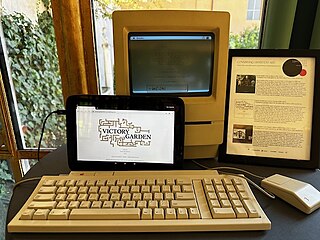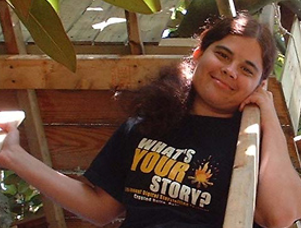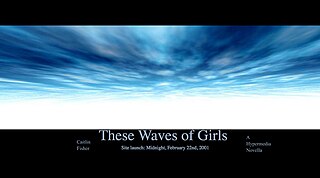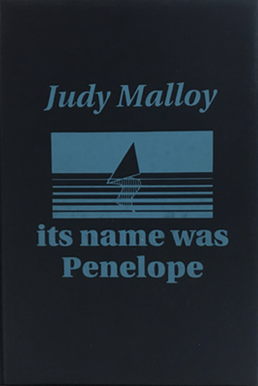Related Research Articles
Hypertext fiction is a genre of electronic literature, characterized by the use of hypertext links that provide a new context for non-linearity in literature and reader interaction. The reader typically chooses links to move from one node of text to the next, and in this fashion arranges a story from a deeper pool of potential stories. Its spirit can also be seen in interactive fiction.
Electronic literature or digital literature is a genre of literature where digital capabilities such as interactivity, multimodality or algorithmic text generation are used aesthetically. Works of electronic literature are usually intended to be read on digital devices, such as computers, tablets, and mobile phones. They cannot be easily printed, or cannot be printed at all, because elements crucial to the work cannot be carried over onto a printed version.

afternoon, a story, spelled with a lowercase 'a', is a work of electronic literature written in 1987 by American author Michael Joyce. It was published by Eastgate Systems in 1990 and is known as one of the first works of hypertext fiction.

Patchwork Girl or a Modern Monster by Mary/Shelly and Herself is a work of electronic literature by American author Shelley Jackson. It was written in Storyspace and published by Eastgate Systems in 1995. It is often discussed along with Michael Joyce's afternoon, a story as an important work of hypertext fiction.

Victory Garden is a work of electronic literature by American author Stuart Moulthrop. It was written in Storyspace and first published by Eastgate Systems in 1991. Victory Garden is one of the earliest examples of hypertext novels, and is notable for being very inventive and influential in its genre. It is often discussed along with Michael Joyce's afternoon, a story as an important work of hypertext fiction.
Stuart Moulthrop is an innovator of electronic literature and hypertext fiction, both as a theoretician and as a writer. He is author of the hypertext fiction works Victory Garden (1992), which was on the front-page of the New York Times Book Review in 1993, Reagan Library (1999), and Hegirascope (1995), amongst many others. Moulthrop is currently a Professor of Digital Humanities in the Department of English, at the University of Wisconsin–Milwaukee. He also became a founding board member of the Electronic Literature Organization in 1999.
Eastgate Systems is a publisher and software company headquartered in Watertown, Massachusetts, which publishes hypertext.
Judy Malloy is an American poet whose works embrace the intersection of hypernarrative, magic realism, and information art. Beginning with Uncle Roger in 1986, Malloy has composed works in both new media literature and hypertext fiction. She was an early creator of online interactive and collaborative fiction on The WELL and the website ArtsWire.

Deena Larsen is an American new media and hypertext fiction author involved in the creative electronic writing community since the 1980s. Her work has been published in online journals such as the Iowa Review Web, Cauldron and Net, frAme, inFLECT, and Blue Moon Review. Since May 2007, the Deena Larsen Collection of early electronic literature has been housed at the Maryland Institute for Technology in the Humanities.
Marjorie Coverley Luesebrink was an American writer, scholar, and teacher. Writing hypermedia fiction under the pen name M.D. Coverley, she is best known for her epic hypertext novels Califia (2000) and Egypt: The Book of Going Forth by Day (2006). A pioneer born-digital writer, she is part of the first generation of electronic literature authors that arose in the 1987–1997 period. She was a founding board member and past president of the Electronic Literature Organization and the first winner of the Electronic Literature Organization Career Achievement Award, which was named in her honor. Lusebrink was professor emeritus, School of Humanities and Languages at Irvine Valley College (IVC).

Figurski at Findhorn on Acid is a hypertext novel by Richard Holeton published on CD-ROM by Eastgate Systems in 2001 and republished on the open web by the Electronic Literature Lab, Washington State University, in 2021. Re-Imagined Radio presented a radio interpretation of this novel in 2022 in which Holeton made an appearance. It is a work of interactive fiction with various paths for readers to choose from, an early example of electronic literature, and one of 23 works included in the literary hypertext canon.

These Waves of Girls is a hypermedia novella by Caitlin Fisher that won the Electronic Literature Organization's Award for Fiction in 2001. The work is frequently taught in undergraduate literature courses and is referenced in the field of electronic literature as a significant example of early multimodal web-based hypertext fiction, placing Fisher "at the forefront of digital writing".

Six Sex Scenes is a hypertext novella created by Adrienne Eisen and published on the web in 1996.
Online Caroline was a web soap opera in 24 episodes written and published online by Tim Wright, Rob Bevan and Tom Harvey at the production company XPT in 2000. It was "an instant hit" and won that year's British Academy of Film and Television Arts award in the interactive category.
King of Space is a work of electronic literature by author Sarah Smith. This interactive narrative is set in a collapsing solar system aboard an abandoned starship, where an escaped terrorist encounters the last star-captain and his ship's Priestess. The story weaves elements of gaming into a dark science-fictional ritual of fertility and regeneration.

Its Name Was Penelope is a hypertext fictional story created by Judy Malloy and published in 1993 by Eastgate Systems. The work makes use of digital elements such as randomized passages to tell the story of the main character's life.

Uncle Buddy's Phantom Funhouse is an early multimedia hypermedia text written by John McDaid and released by Eastgate Systems in 1993. The main portion of Funhouse was written for Macintosh's HyperCard app, but portions of the hypermedia novel are also contained in the original box. The use of transmedia storytelling, meta-fiction, and epistolary format makes this a potential early example of an alternate reality game.
Twelve Blue is a work of electronic literature by American author Michael Joyce. He is widely known as one of the first writers of hypertext fiction. His first piece afternoon, a story was written in 1987. Joyce created Twelve Blue in 1996 using Storyspace software. This is his first piece of hypertext fiction specifically to be played on the web and published by Eastgate Systems. In 2006, Twelve Blue was selected for inclusion in the first volume of the Electronic Literature Collection, a publication of the Electronic Literature Organization.
The NEXT: Museum, Library, and Preservation Space is a repository of net art, electronic literature and games. It is supported by Washington State University at Vancouver and the Electronic Literature Organization. This is a digital museum dedicated to reviving and maintaining these works to make them accessible to all. Physical artifacts are held at the Electronic Literature Lab in Washington, US.
References
- 1 2 Pope, James (2009). "The significance of navigation and interactivity design for readers' responses to interactive narrative: Some conclusions from an empirical study of readers' responses". Dichtung Digital. Journal für Kunst und Kultur digitaler Medien. 11.
- ↑ "NFSA - Search the Collection". www.collection.nfsa.gov.au. Retrieved 1 March 2024.
- ↑ "Megan Heyward | ELMCIP". elmcip.net. Retrieved 4 December 2023.
- 1 2 3 4 "Rebooting Electronic Literature Volume 3: Megan Heyward's "of day, of night"". Rebooting Electronic Literature Volume 3: Documenting Pre-Web Born Digital Media. Retrieved 4 December 2023.
- ↑ Idowu-faith, B. O. (2012). Hyperfictional Language in Michael Joyce's Afternoon, a Story and Megan Heyward's of Day, of Night (PDF) (PhD thesis).
- ↑ Swalwell, Melanie; Stuckey, Helen; Vries, Denise de; Moya, Cynde; Cranmer, Candice; Frost, Sharon; Goddard, Angela; Miller, Steven; Murphy, Carolyn; Richardson, Nick (1 December 2022). "Archiving Australian Media Arts: A Project Overview". Preservation, Digital Technology & Culture. 51 (4): 155–166. doi: 10.1515/pdtc-2022-0026 . ISSN 2195-2965.
- ↑ Swalwell, Melanie. "The Australian Emulation Network: Accessing born-digital cultural collections" (PDF).
- 1 2 Heyward, M. E. (January 2005). "of day, of night".